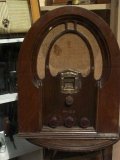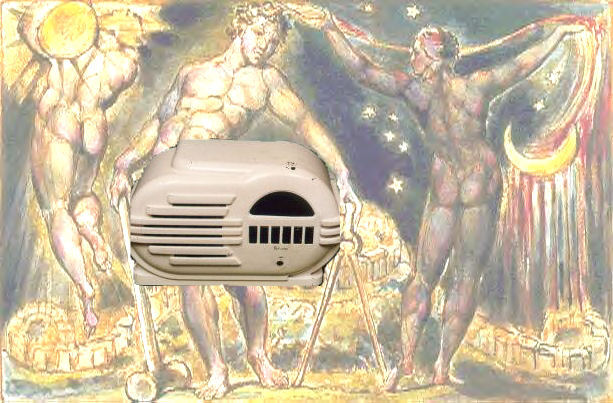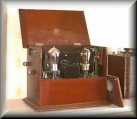McPhee, Scott, 1996, 'Audio visual poetics in interactive multimedia'
|
This article has disappeared from the internet, which is unfortunate. I have found it valuable. I cited it: Beck, Alan, 2002, The Death of Radio? An Essay in Radio Philosophy for the Digital Age. Online book. Published by Sound Journal I note also Scott McPhee's 'Audio visual poetics in interactive multimedia' (McPhee 1999). He denounces the sound quality of the present Internet bandwidth. Listeners to MP3 files, of an age above the usual 'pop pickers', and accustomed first to 'warm' vinyl and then to CDs, have found the new-format music thin, shallow, fuzzy and unreal.
Here are some short excerpts from McPhee: |
| The purpose of this essay, bluntly put, is to ascertain a general structure that describes the audio-visual logic of multimedia in way that draws the question of sound, regarded here as including sonic as well as poetic logic, to the centre of the entire apparatus. |
| Sound, being a "real-time" medium requiring considerable bandwidth, is not well-suited to the current web form, although there are (currently inferior) methods for delivering less than telephone quality sound to the viewer over the network. It can be assumed that the CD-ROM paradigms will be the dominant ones for rich multimedia experiences once the technical problems with networks are solved. The user (Browser? Reader? Viewer?) visits this mediated space almost exclusively by force of the mouse, the keyboard, and the computer monitor, as a kind of expanded television (one might point out that one is forced to sit closer to this monitor than one's mother ever allowed in relation to the TV set whilst watching Saturday morning cartoons). Added to this picture of a domesticated interface is the question of sound that is always seemingly a poor cousin to the visual elements, provided so frequently as it is through small tinny speakers hardly worthy of a cheap transistor radio. |
| We are so used to dealing with this interface without sound in our "normal" range of computerised activities (such as the wordprocessing I am performing now, where the computer is mute and only the sound of its cooling fan and my fingers on the keys interrupt the acoustic environment), that this technically inferior sound reproduction system is rarely given much thought in its relationship to the screen, often even by critics who should realise better. Usually their arguments are reduced to musicological examination and valorisation of "technical perfection" in systems without much reference to anything but emotive effects and physics, the same types of attention to sonic detail as found in hi-fi boutiques or popular film criticism. That this is not surprising goes without saying. We had the "sound" film (or more precisely the "talking" picture) for nearly some sixty years before a large range of critical theory engaged with it and interrogated its (now central) role in constructing cinematic experience. This con be contrasted against the much larger body of criticism invoking narrative and visual effects. That much multimedia is produced with an overwhelming priority on (usually slick) visual design is not likely to stupefy many familiar with the field of sound studies. |
|
In his catalogue essay [2] for Burning the interface, Murray
documents the increasing influence of "ambience", first
in daily life: "If it didn't sound paradoxical, we might say that ambience is the anthem of the late millennium." [3] And from that, multimedia art: "It is not just art CD-ROMs which draw on ambience. Commercial works titles rely heavily on aural fields to enmesh their players. This can be incidental (casual walks down ancient Greek paths in Wrath of the Gods), a highlight (sounds evoking rainforest environment that is the central concern in SimIsle) or part of the logic of the work itself (noises like cricket chants from the desert sands of East Africa used as a repertoire of geographical difference in Encarta '96 World Atlas). So why is ambience everywhere?" [4] Indeed, why is it? Murray fails to see past the musicological categorisation of the "ambient" genre and grasp the deep affinity that "ambience" in all its forms has within multimedia. In the first case I mean ambient "genre" to mean a practical approach to making electro-acoustic music, as well as a description of the resulting music [5]; by the second - "ambience" - I mean the process of mapping, marking or indicating, an exterior terrain or space with sounds in order to produce an interior, as well as exterior, sense of that space - the deep reverb of the cathedral, for example, not only materialises the physical space of the church, it also invokes within the individual a psychological sense of the space. So it is not just a matter of nature being a set of easily coopted recurrent sounds that drives the contemporary dominance of ambience (of the first kind) in multimedia [6] but a relation of subjects to the medium that is created by such within the bounds of the second sense of the term. The soothing features of a quiet natural environment are but one possible set of aesthetic (and political |
|
What then 'writes' the viewer into the piece? How are we,
striding hopelessly through this empty landscape of signposts,
sutured into its disjointed memory? The element which is most
at work here is the imaginary landscape conjured up by the non-diegetic
sound of the soundtrack. It is the ambience of the work which
represents the viewer in it. That is, the ambient, acousmatic
music of the piece does not mark out the 'territory' of the logically
represented on-screen space but it marks out the inner subjectivity
of the viewer. The ambience is the accumulated memory of the
reader, in the process of 'becoming' - being modified by the
circulatory flow in the work we observe. The ambiences of different
regions become earcons for, that is they are iconic of, subjective
experiences and memories of the viewer, particularly where these
need to be related to a particular space, or a direct emotional
feeling (as in music). Here we find a major departure from the ontologically privileged position given to the gaze in regular cinematics. The screen is no longer the reference point, the origin, for a physically "real" world into which the viewer is given a view and "point of audition" [31], either omniscient-to or subjective-within. The whole system acts as a portal to another universe, an interior world. The defining moment for multimedia, what makes the inter-texualisation between sense-data possible in this context, produces the interior contemplation required, is the flow of sounds that supposedly originate from the collective unconscious of the spectator, and it is this acoustic field which links the subjective moment in the work to the subjective state of the viewer. |
|
This concept of networked virtuality, can be equated also
with notions of aurality, which for Fran Dyson at least are related
by their "phenomenal invisibility, intangibility, multiplicity,
and existential flux" [40]. Sound is "an agent of destabilisation"
[41] which "challenges an understanding of the real based
on the physical, visible and enduring object." [42] She
also identifies a strong link between the history of radio and
the unfolding rhetoric of virtuality - in that radio offers "another
example of presence recuperated via the often spiritualised notion
of embodiment" [43], and both were/are used to idealise
a form of "supra" subjectivity, a mass subjectivity
popularly thought of as a type of collective unconscious or mystical
being. In this respect at least, the history of early radio offers
us many insights into the political discourse which surrounds
such networks. However, especially given the latent impulse that
"virtual" sound has to rendering physical space, it
also provides interesting pointers for constructing an aesthetics,
an ambient radio poetics, in some ways perhaps reviving early
utopian models of radio broadcasting which were largely pushed
aside in the fight over defining the "citizen-consumer"
[44]. To be sitting back in front of a multimedia work, peering at the flickering monitor, clicking with the mouse like a rat pressing a lever, reading our televisual book and inhabiting our internal space, the most pressing need of multimedia seems too frequently to be the need of real, physical, space rather than any virtual one. The exhibition gallery space for example does not really appear to be the ideal venue for the new media, even those made by artists. And even as a private form used in the home it certainly requires further "domestication" for it to claim the "market penetration" of television (for which the future multimedia Internet is often is touted as a replacement). That this issue of bodily ergonomics is a key future question is not questioned here. But it's not just an ergonomics of the body that computer-based multimedia requires, but also an ergonomics, or energy distribution, of meaning or poetics, in the form itself. Ultimately this is what this essay is really concerned with, and I hope that it has at least started, in its own fashion, to provide glimpses of this fragmented territory. (Ends) |
|
|



